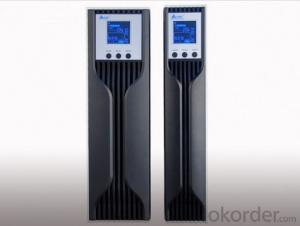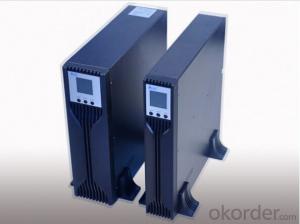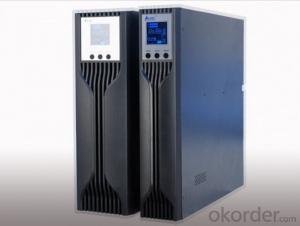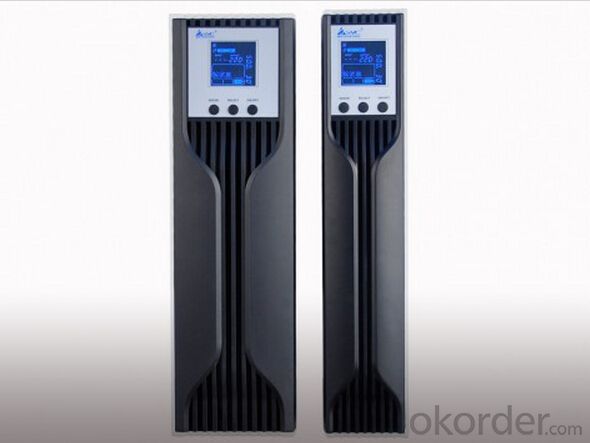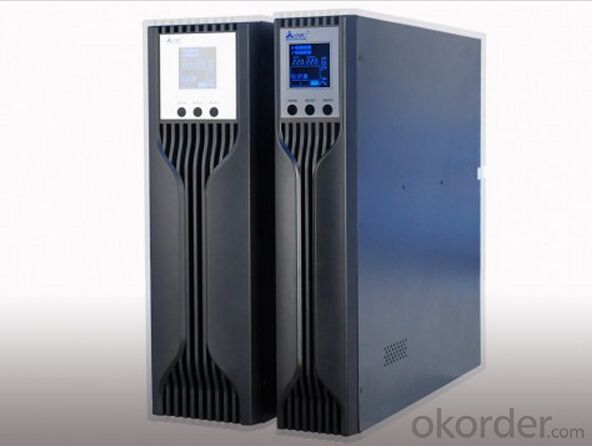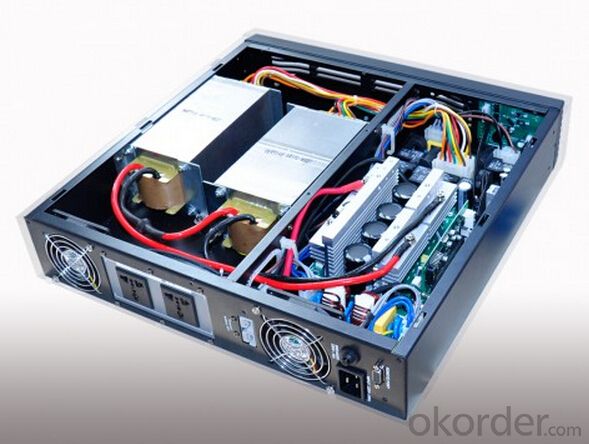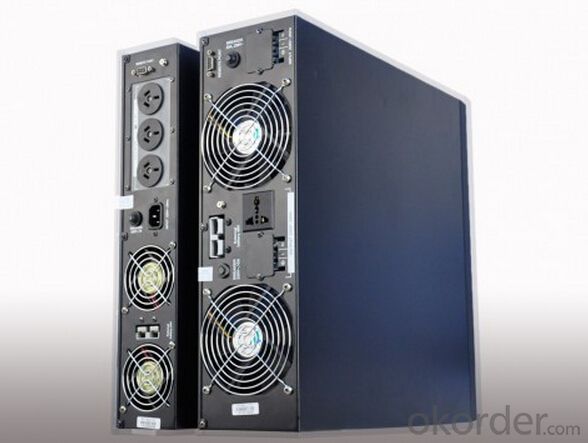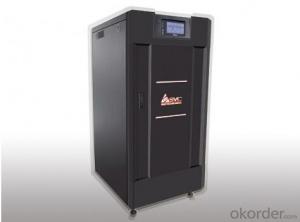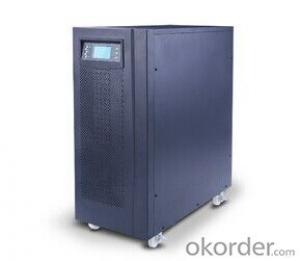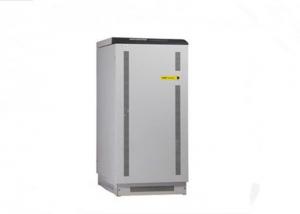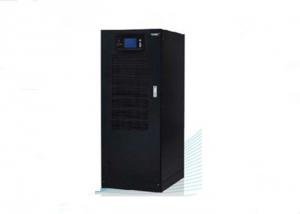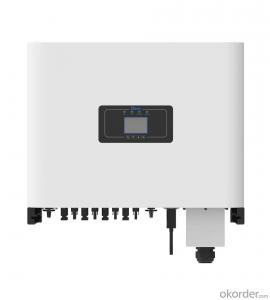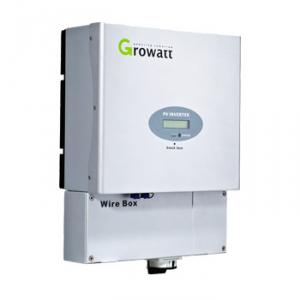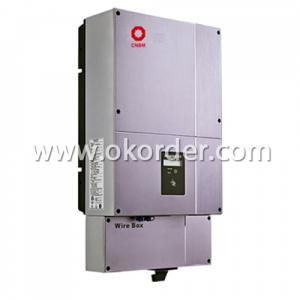Ingeteam Solar Inverter 20~30kVA Online Low Frequency 3 in 3 out Double Conversion UPS
- Loading Port:
- Guangzhou
- Payment Terms:
- TT OR LC
- Min Order Qty:
- 30 unit
- Supply Capability:
- 300000 unit/month
OKorder Service Pledge
OKorder Financial Service
You Might Also Like
20~30KVA Online Low Frequency 3 in 3 Out Double Conversion UPS

1. Wide range of input voltage
The UPS can offer normal and stable service voltage under its input voltage range. When the input voltage is out of its range the machine will switch to battery mode automatically to keep the output power in order to protect the equipment, such as computers, ensure they will not be damaged by the over high or over low voltage, users can continue the operation of equipment for a while or save the data on computers while the power network is abnormal.
2. Wide range of AVR(Automatic voltage regulation)
In the product’s input voltage range and under 3 steps of intelligent AVR function, it can provide a stable output voltage.
3. Automatic self detection when UPS on(LED).
Before the UPS on, red, yellow, blue LED will light up two times by cycle turns, after self detection UPS switch to AC mode/battery mode or working mode.
4. Silence function
In the "battery mode", shortly press the switch to turn off the buzzer. But the battery is about to run out or the load is too heavy, the buzzer sound cannot be muted.
5. Overload protection
In the battery mode, output voltage turn down correspondingly when it is overload, after the capacity of load is lower than the rated power then output voltage will back to rated value, it ensures the UPS will not shut down by abrupt overload which caused by surging current during the computer is working and other equipment is added.
6. Short circuit protection
When the mis-operation caused the load short circuit or computer failure (such as power tube breakdown of switch) cause short circuit, the UPS will shutdown automatically for protection.
7. The low current switch
This UPS adopts low current switch to extend the service life which is longer than conventional battery and high current switch in AC current path.
8. Automatic charging
There are two charging mode, charging time is faster than ordinary charging mode, higher efficiency, and greatly prolonging the service life of the battery.
9. With a bypass output
Independent bypass output socket for external printers or scanners of computer peripherals, with surge protection of the load.
| MODEL | GP33-20-30 | GP33-40-60 | GP33-80-100 | GP33-120-200 |
| Capacity | 20~30KVA | 40~60KVA | 80~100KVA | 120~200KVA |
| Type | Tower | |||
| INPUT | ||||
| Voltage | (208 or 380 or 400 or 480 Vac) ± 20% / 5 wires (3 Lines + Neutral + Ground) | |||
| Frequency | 50 or 60Hz ± 10% Autosensing | |||
| Power factor | 0.98 | |||
| Filter | EMI, RFI | |||
| Dual input | Optional | |||
| OUTPUT | ||||
| Voltage | (208 or 380 or 400 or 480 Vac) ± 20% / 5 wires (3 Lines + Neutral + Ground) | |||
| Frequency | 50 or 60Hz ± 0.1% | |||
| Effciency | AC / AC > 92% | |||
| Trandfer time | 0 ms | |||
| Wave form | Sine wave | |||
| Power factor | 0.9 | |||
| Voltage T.H.D. | < 2% with linear load< td=""> | |||
| Crest factor | 3 : 1 | |||
| Technology | True on-line double conversion controlled by microcontroller | |||
| Overload recovery | Automatically transfer to UPS mode | |||
| Isolation transformer | Inverter mode ( bypass mode is optional ) | |||
| Parallel connection | Parallel connection function is ready (extra PCB is not required ) | |||
| BATTERY | ||||
| Battery type | VRLA ( Valve Regulated Lead Acid ), not included | |||
| DC voltage | 384 Vac | 480 Vdc | ||
| Charging time | 4 hours up to 90% | |||
| Battery detection | self-detect, transfer to battery mode adjustable | |||
| PROTECTION | ||||
Lighting and transient protection | Hotswappable lightning and transient surge suppressor (In:10 Kamp, Up:1.5 Kv, I max : 20 K amp. ) | |||
| Hardware protection | output breaker, battery breaker, bypass breaker; DC fuse, fan, redundant power supply; temperature sensor, EPO (Emergency Power Off), audible alarms etc. | |||
| Software protection | Discharging batteries, battery charge working mode, inverter working mode, emergency power off, manual shutdown, bypass SCR failure, bypass sequence failure, bypass over the lilit, critical overload, batteries exhaustion, low or high output voltage, DC fuse open, 5v power supply failure, 13.5V power supply failure, inverter overvoltage, 200% overload on each line, transfer failure, inverter voltage out of range, over voltage between neutral and ground, UPS on bypass mode, bypass frequency out opf range. | |||
| Bypass | Solid state | |||
| Overload | 125% for 10 min, 150% for 30 sec, 1000% for 16 millisencond. | |||
| EPO | EPO local and / or remote | |||
| Display | LCD, touch screen | |||
| LED's diagram | Included | |||
| Communication | RS232 intellident Slot, modem, SNMP(RJ45) (SNMP adaptive Software is supplied by the producer) | |||
| ENVIRONMENT | ||||
| Elevation | 1.700 m.o.s. 1 without derrating | |||
Temperature & noise | 0℃~40℃ / < 60db @ 1.5m.< td=""> | |||
| Humidity | Non condensate | |||
| PHYSICAL | ||||
| Dimension(mm) | 520*1600*550 | 520*1670*780 | 1000*1860*870 | Ask for information |
Weight (without batteries) | 150 | 300 | 600 | |
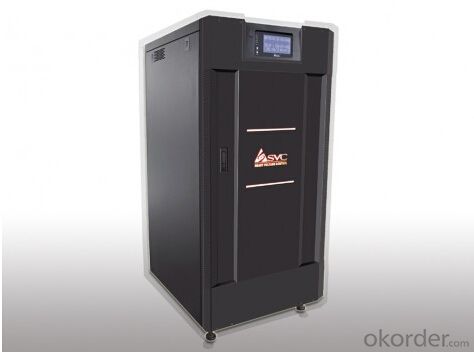
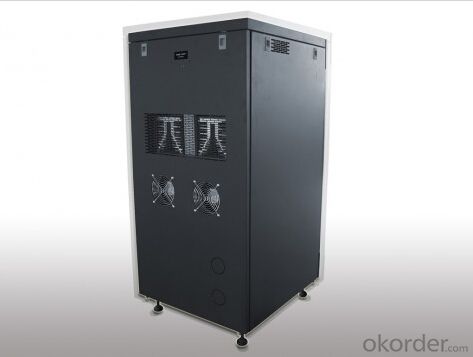
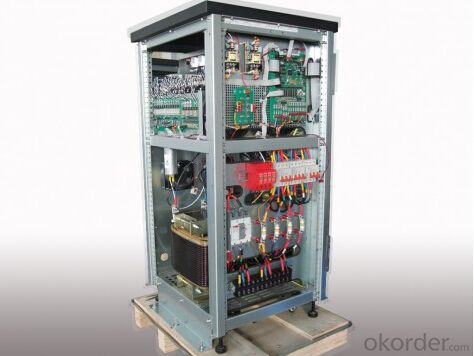

FAQ
1. Where can I buy your products?
You could find our products from dealers or contact our sales team directly. We will provide you with detailed services.
2. How to contact us?
Contact details can be found from website www.okorder.com to contact us. We look forward to providing you with professional services.
3. What is the application field of your products?
Our current GW1500~4600-SS series and GW3000~4600-DS, with the flexible expansion ability and allocation capability, can be used in the small photovoltaic (PV) grid power generation systems of family units as well as the commercial photovoltaic system such as BIPV, BAPV and etc.
4. What kinds of modules do your inventers support?
Our inventers support most of mainstream components and modules in the market. Should you require more details, please do not hesitate to contact our technical personnel.
- Q: How does a solar inverter handle power quality disturbances?
- A solar inverter handles power quality disturbances by continuously monitoring the electrical grid and adjusting its output accordingly. It employs various techniques such as voltage regulation, frequency control, and power factor correction to ensure that the power it feeds into the grid is of high quality and meets the required standards. Additionally, some advanced solar inverters also have built-in features like anti-islanding protection to prevent the injection of power into the grid during a disturbance, ensuring the safety of both the solar system and the grid.
- Q: Can a solar inverter be used with a solar-powered street lighting system?
- Yes, a solar inverter can be used with a solar-powered street lighting system. A solar inverter is responsible for converting the direct current (DC) produced by solar panels into alternating current (AC) that can be used to power electrical devices. In the case of a solar-powered street lighting system, the solar inverter can convert the DC power generated by the solar panels into AC power to operate the street lights. This allows the system to efficiently utilize the energy generated by the sun and provide reliable lighting for the streets.
- Q: What is the role of an anti-islanding function in a solar inverter?
- The role of an anti-islanding function in a solar inverter is to ensure the safety of utility workers and prevent damage to the grid during a power outage. It detects if the grid is down and immediately disconnects the solar system from the grid, preventing the solar inverter from continuing to operate and potentially backfeeding electricity into the grid. This functionality is crucial in maintaining grid stability and protecting personnel working on the power lines.
- Q: Are there any government incentives for installing a solar inverter?
- Yes, there are government incentives available for installing a solar inverter. Many countries and states offer various financial incentives, such as tax credits, rebates, grants, or low-interest loans to promote the adoption of renewable energy technologies like solar inverters. These incentives aim to encourage individuals, businesses, and organizations to invest in clean energy solutions and reduce their carbon footprint. It is advisable to check with local government authorities or renewable energy agencies to determine the specific incentives available in your area.
- Q: What is the role of a solar inverter in preventing system failures?
- The role of a solar inverter in preventing system failures is to convert the direct current (DC) produced by solar panels into alternating current (AC) that can be used by household appliances and sent back to the electrical grid. By ensuring that the DC power generated by the solar panels is properly converted and synchronized with the grid, the inverter helps maintain the stability and reliability of the entire solar power system. Additionally, the inverter monitors the voltage, frequency, and overall performance of the system, allowing it to detect and respond to any potential issues or faults that could lead to system failures.
- Q: How is the output voltage of a solar inverter regulated?
- The output voltage of a solar inverter is regulated through the use of control circuitry and power electronics components. These components monitor the input voltage from the solar panels and adjust the output voltage to meet the desired specifications. The control circuitry ensures that the output voltage remains stable and within the required range, even when there are fluctuations in the input voltage or varying load conditions.
- Q: How does a solar inverter handle sudden changes in solar irradiation?
- A solar inverter handles sudden changes in solar irradiation by constantly monitoring the incoming solar energy and adjusting its output power accordingly. When there is a sudden increase in solar irradiation, the inverter increases its power output to match the higher energy generation. Similarly, when there is a sudden decrease in solar irradiation, the inverter reduces its power output to align with the lower energy production. This dynamic response ensures the inverter efficiently converts the available solar energy into usable electricity, regardless of variations in solar irradiation.
- Q: How does MPPT improve the efficiency of a solar inverter?
- MPPT (Maximum Power Point Tracking) improves the efficiency of a solar inverter by continuously adjusting the operating point of the solar panels to ensure they are producing maximum power. This is achieved by maximizing the voltage and current output of the panels, which allows the inverter to convert more of the available solar energy into usable electricity. By constantly tracking the maximum power point, MPPT ensures that the solar inverter operates at its highest efficiency, resulting in increased overall system efficiency and improved energy generation.
- Q: What is the role of a solar inverter in fault ride-through capability?
- The role of a solar inverter in fault ride-through capability is to help maintain the stability and reliability of the power grid during faults or disturbances. By detecting and responding to voltage and frequency variations caused by faults, the solar inverter can adjust its output and remain connected to the grid, ensuring continuous power supply. This capability is essential for grid stability and allows solar power systems to contribute to the overall reliability of the electrical network.
- Q: Can a solar inverter be used with a solar-powered water heating system?
- Yes, a solar inverter can be used with a solar-powered water heating system. The solar inverter converts the direct current (DC) generated by the solar panels into alternating current (AC) that can be used to power the water heating system. This allows for efficient utilization of solar energy and ensures the water heating system operates effectively.
Send your message to us
Ingeteam Solar Inverter 20~30kVA Online Low Frequency 3 in 3 out Double Conversion UPS
- Loading Port:
- Guangzhou
- Payment Terms:
- TT OR LC
- Min Order Qty:
- 30 unit
- Supply Capability:
- 300000 unit/month
OKorder Service Pledge
OKorder Financial Service
Similar products
Hot products
Hot Searches
Related keywords
